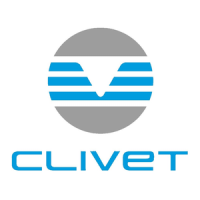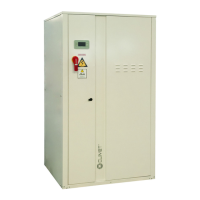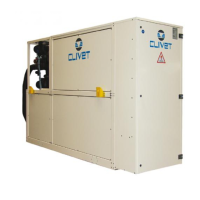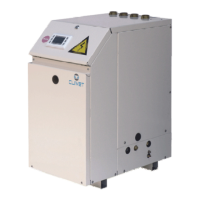6.14 Evaporator water ow-rate
Check that the dierence between the temperature of exchanger return and supply water corresponds to power according to this formula:
unit cooling power (kW) x 860 = Dt (°C) x ow rate (L/h)
The cooling power is shown in the table of the GENERAL TECHNICAL DATA included in this manual, referred to specic conditions, or in the
tables on COOLING PERFORMANCE in the TECHNICAL BULLETIN referred to various conditions of use.
Check for water side exchanger pressure drops:
determine the water ow rate
measure the dierence in pressure between exchanger input and output and compare it with the graph on WATER SIDE EXCHANGER
PRESSURE DROPS
The measurement of pressure will be easier if pressure gauges are installed as indicated in the DIAGRAM OF SUGGESTED WATER CONNECTIONS.
6.15 Inverter driven variable ow-rate cooling side control depending on the temperature
dierential
This option allows water ow-rate modulation to the unit during partial load conditions, maintaining stable the temperature dierence
between inlet and outlet to the heat exchanger.
Designed for systems with primary circuit variable ow-rate systems decoupled from secondary circuit. With no building load the unit switches
o the compressors while concerning pumps is possible to select:
•
active pumps with minimum ow-rate, monitoring secondary circuit temperature variations (par. P0079 EnQVarUtil = 2; par. P0080
DelayPeriodUt = < 60 sec)
•
Pump switching o, periodically activating them (settable time par P0080 DelayPeriodUt) leading secondary circuit temperatures on
primary circuit (par. P0079 EnQVarUtil = 0)
•
Pump switching o and waiting for the user signal for activation (free potential; par. P0079 EnQVarUtil = 0)
Flow-rate modulation is managed by embedded logic thanks to built-in ow-rate control device and temperature probes. This device is
installed and wired.
This option is available only with inverter driven HYDROPACK selected (2PMV / 3PMV)
6.16 Scroll compressor
The Scroll compressors have only one rotation direction.
In the event it is reversed, the compressor is not immediately damaged, but increases its noise and jeopardises pumping.
After a few minutes, the compressor blocks due to intervention of the thermal protection.
In this case, disconnect power supply and invert 2 phases on the machine power supply.
Avoid the compressor working for a long time with contrary rotation: more than 2-3 of these anomalous start-ups can damage it.
To ensure the rotation direction is correct, measure the condensation and suction pressure.
The pressures must signicantly dier: upon start-up, the suction pressure decreases whereas the condensation one, increases.
6.17 Operating at reduced load
The units are equipped with partialization steps and they can, therefore, operate with reduced loads.
However a constant and long operation with reduced load with frequent stop and start-up of the compressor/s can cause serious damages
for the lack of oil return.
The above-described operating conditions must be considered outside the operating limits.
In the event of compressor breakdown, due to operating in the above-mentioned conditions, the guarantee will not be valid and Clivet spa
declines any responsibility.
Check periodically the average operating times and the frequency of the compressors starts: approximately the minimum thermal load
should be such as to need the operating of a compressor for at least ten minutes.
If the average times are close to this limit, take the proper corrective actions.
6.18 Start-up report
Identifying the operating objective conditions is useful to control the unit over time.
With unit at steady state, i.e. in stable and close-to-work conditions, identify the following data:
•
total voltages and absorptions with unit at full load
•
absorptions of the dierent electric loads (compressors, fans, pumps etc)
•
temperatures and ows of the dierent uids (water, air) both in input and in output from the unit
•
temperature and pressures on the characteristic points of the refrigerating circuit (compressor discharge, liquid, intake)
The measurements must be kept and made available during maintenance interventions.
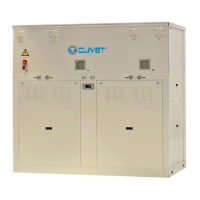
